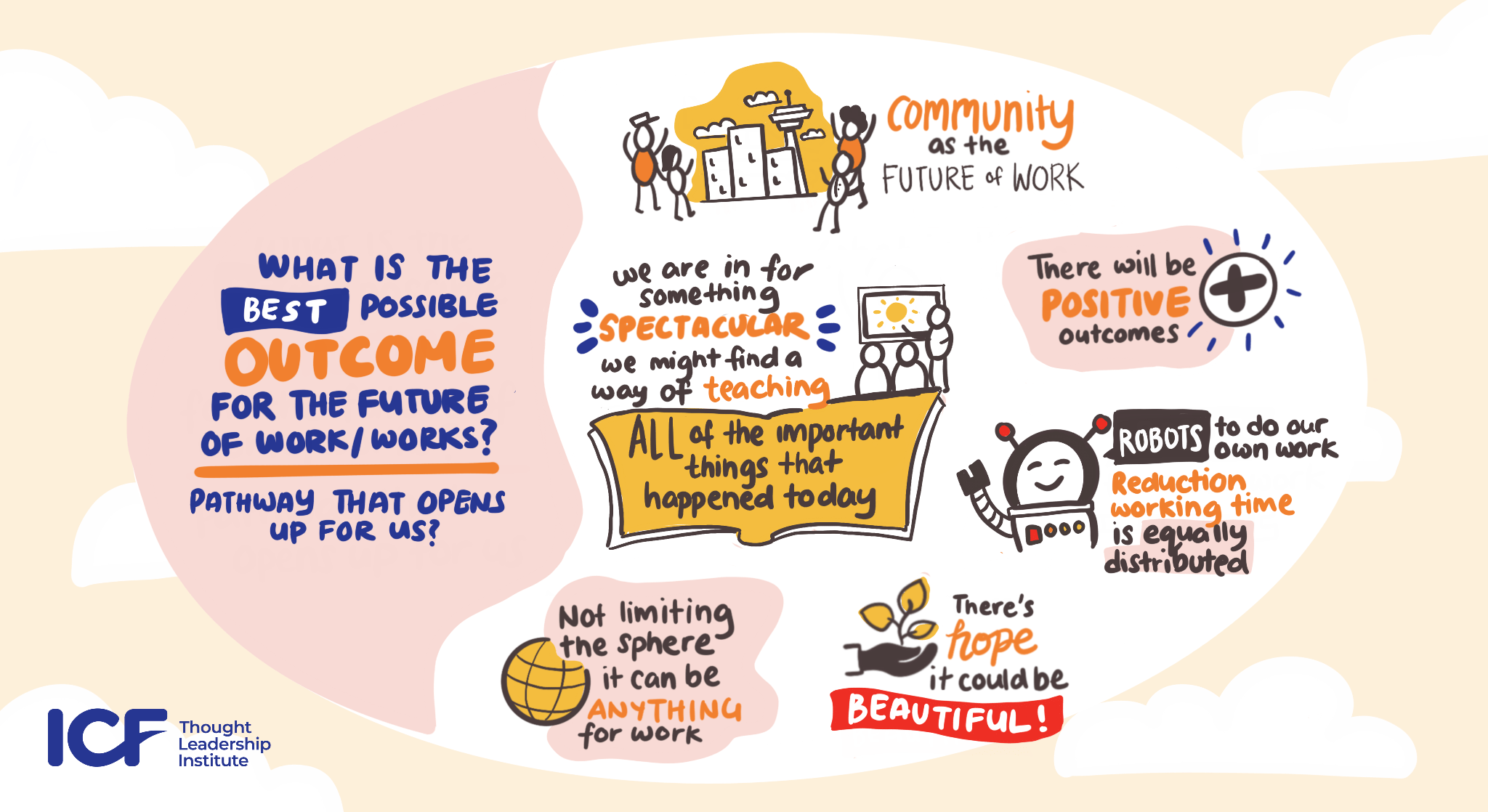How coaching approaches help managers cultivate collaborative teams
Managers can use coaching approaches to develop cohesive and collaborative teams by establishing a culture of trust and mutuality.
Collaborative teams are built on mutuality
The World Economic Forum lists collaboration as a core social skill for the future. In the world of work, businesses are already stretching to collaborate both internally and externally as the world becomes increasingly complex and interconnected. Very few aspects of modern work are purely independent. Projects pass through multiple departments as they are designed, implemented, marketed, and sold. Along the way, teams and workgroups of internal staff and external contractors work together to contribute unique skills or meet different stakeholder needs.
Research on team dynamics indicates that cohesive teams have a sense of mutual trust, respect, and shared goals. Managers can set the tone for mutuality by using coaching approaches that open lines of communication and invite team members to participate in decision-making. Leaders foster a culture of trust, respect, and collaboration in the way they interact with their teams. When managers place themselves outside the team structure, communication flows in one direction, limiting opportunities for team members to share concerns, options, or new perspectives. Coaching approaches place leaders within their teams, inviting members to co-create solutions. A Deloitte review of enhanced worker agency highlights how more employees report wanting greater autonomy and shared-decision making. Inviting employees to participate in decision-making and planning conversations can support innovation and increase feelings of shared purpose. These types of conversations also reinforce the value of collaboration in employee interactions.
Managers can use coaching approaches to set an example for collaborative team culture by:
- Catalyzing action around shared goals
- Fostering curiosity to examine multiple perspectives
- Empowering team members to co-create solutions
- Facilitating partnerships around complementary strengths
- Acknowledging individual and team contributions
1. Shared goals can unite teams and strengthen engagement
Organizations are adopting strategies centered around external impact in a growing push for purposeful work. Managers can leverage this trend by helping team members connect their personal values with organizational goals. The 2023 Edelman Trust Barometer reports that in a global survey, 69% of respondents strongly expect their job to support greater social impact. Reports on Gen-Z workplace expectations indicate young workers would change jobs if their employer were not making a tangible impact on social and environmental issues. In short, employees want to feel that their work matters and aligns with their values. Whereas coaching conversations use open questions to understand client values, motivations, and goals, managers can use a similar approach to elicit team values.
Managers can take a coaching approach to explore team purpose by asking open questions, such as:
- What makes you feel energized or fulfilled?
- How do your values shape the work that you do?
- What might you want to achieve if you follow your purpose?
- What steps might you take to achieve your ultimate goals?
Managers can introduce conversations around values and motivations through individual and team meetings. When team members are together, managers can use these conversations to explore where values overlap and how these values shape the work being done. Team members may also reveal areas where work could contribute to a greater sense of meaning and purpose.
In a survey of successful teams at Google, Google Human Resources found that in addition to psychological safety, effective teams have a shared belief that their work is personally meaningful and contributes to greater impact or change. Purposeful work helps increase employee motivation and, in groups, strengthens a sense of shared identity between team members.
2. By fostering curiosity, managers hold space for multiple perspectives
Teams with a strong sense of shared identity can sometimes devolve into groupthink that limits diverse opinions. When managers practice curiosity, they invite their employees to share new ideas, propose alternative solutions, or offer fresh ways of considering a challenge. Similarly, coaches practice curiosity to help clients examine underlying assumptions, take an outside perspective, or imagine new possibilities. Managers who want to promote curiosity in their teams can ask open, non-leading questions that leave room for multiple answers.
Asking team members to imagine an alternative perspective takes the conversation away from consensus and prioritizes creativity. Cohesive teams with foundational trust value the diverse perspectives and skills of each team member resulting in greater curiosity and knowledge sharing. Curiosity helps groups explore how differences, including cultural values, generational divides, and unique life experiences, contribute to more nuanced decision-making or help understand new dimensions of team impact. Within a team, this type of trust opens lines of communication and can lead to better solutions.
3. Inviting team members to co-create solutions promotes team leadership and decision making
Coaching is a partnering relationship built on shared discovery. When managers partner with team members to collectively set goals or examine a challenge, they acknowledge the expertise and knowledge of their team members. As a development strategy, when employees are engaged in decision-making conversations or co-create knowledge, it strengthens the employee’s confidence and individual capacity to work independently. Managers who invite their teams to co-create solutions improve team engagement and confidence. A study in China with industrial workers found that in addition to individual development, participatory decision-making enhanced innovation.
These kinds of shared decision-making conversations also help team members feel greater ownership over their work and prepare team members to navigate change. However, leaders may find that engaging with employees to co-create solutions goes counter to workplace norms where leaders are expected to have all the answers. As a product of this model, some employees may find it challenging to make decisions or fear they will make the ‘wrong’ choice. As managers continue to engage their teams in collaborative decision-making, they foster a culture of mutual respect and open communication. When employees are invited into decision-making conversations with their manager, it encourages team members to prompt collaborative conversations with partners both within and outside of their team.
4. Identifying strengths helps team members collaborate in complementary ways
In addition to supporting curiosity and participatory decision-making, managers can use strengths-based approaches to enhance collaboration in teams. Coaching to strengths involves a process of exploring which capacities, skills, and passions help individuals achieve their goals. Understanding strengths helps clients energize their work in a way that enhances motivation and effectiveness. As a coaching approach, investigating strengths is about awareness, not about prescribing a development plan or assigning tasks. When managers use strengths-based coaching approaches, the emphasis is on fostering individual and team awareness and appreciation for strengths in a way that equips teams to collaborate.
Strengths-based conversations can help team members understand how different strengths complement each other when tackling complex challenges, adding to a sense of mutuality and appreciation for team members. Strengths awareness also helps employees lean into their strengths when navigating a new project. Managers can enhance problem solving when employees report challenges by prompting team members to consider how their strengths might lend to different solutions. Managers can also facilitate connection around strengths by asking individuals to consider how other team members’ strengths might be a resource for tackling the problem.
5. Acknowledging team and individual contributions further incentivizes collaboration
Similar to one-on-one interactions between a manager and employee, teams thrive off a combination of recognition and appreciation. Harvard Business Review emphasizes the importance of combining recognition and appreciation for employee engagement because people like to be recognized for their achievements and also need to feel appreciated for their inherent value as a person. Coaching combines recognition and appreciation through acknowledgement – the process of connecting a person’s attributes to their growth process and success. For example, coaches might celebrate client accomplishments by acknowledging how client strengths contribute to goal attainment. In the workplace, managers can model this same approach by highlighting the team attributes that support successful work in addition to applauding the role of collaboration in project completion.
When managers acknowledge their teams as a collective and as a sum of talented individuals, they model the importance of collaboration. In team meetings, managers can also invite team members to share how their colleagues contribute unique talents or perspectives to complement the whole. The act of inviting team members to practice acknowledgment can help strengthen a sense of trust and mutual respect between members and further aid collaboration.
Talent Development professionals and managers can use the following coaching approaches to cultivate collaborative teams:
- Inviting team members to participate in decision-making and planning conversations
- Introducing conversations around values and purpose that contribute to a sense of shared vision and identity among team members
- Encouraging team members to make decisions and evaluate their outcomes from a growth mindset that values learning from both successes and failures
- Focusing on individual team members’ strengths and opportunities to plan and problem-solve engaging these strengths
- Fostering a culture of gratitude and acknowledgement for individual team member contributions
Coaching Empowers People
Coaching as a profession involves a collaborative process of discovery between the coach and client to help reveal new opportunities for growth and action. Increasingly, managers and leaders who have benefited from coaching are integrating coaching approaches into their leadership style to aid team development. In the article “An exploration of managers and leaders using coaching skills,” researchers DiGirolamo and Tkach collate research and develop new understanding of coaching skills in leadership. They explain how the collaborative foundation of coaching supports participatory management but may not be as effectively implemented in directive management styles, where managers deliver expectations and tasks for employees without engaging their perspectives. DiGirolamo and Tkach then interviewed and surveyed managers and their teams using validated scales on engagement, intention to quit, and perceived relationship with managers. The results indicate that the use of coaching skills correlated with team engagement and a perceived positive relationship between team members and their manager.
Another example from professional coaching research illustrates the impact of managers and leaders using coaching skills on dynamics for collaboration between team member. In a case study exploring organizational transition from hierarchical leadership to a holacratic structure (non-hierarchical and self-governing), team coaches worked with the organization to build upon existing collaborative strengths while navigating change. Team members in the case example reported having strong communication and respectful relationships but needed clarity on role and purpose in the new organizational structure. Coaches worked with the team to open lines of communication and invite diverse perspectives to collaboratively define the new shared purpose and vision for the team. As a result, team members reported having greater psychological safety and trust to discuss issues and have constructive conversations around challenges. Coaching supported the changes needed to strengthen collaboration in a way that enhanced the teams’ ability to achieve organizational success.




